Sensor Sweep: Conan, Robert E. Howard, D&D Comic Ads, Lloyd Alexander
Monday , 24, June 2024 Sensor Sweep Leave a commentWeird Tales (Tellers of Weird Tales): Three stories appeared in Weird Tales under the byline “Houdini.” I have nominated Otis Adelbert Kline as the author of the first, “The Spirit Fakers of Hermannstadt” (two-part serial, Mar.-Apr. 1924). John Locke has offered Harold Ward as possible author of the second, “The Hoax of the Spirit Lover” (Apr. 1924). The third story, “Imprisoned with the Pharaohs” (May/June/July 1924), is known to have been the work of H.P. Lovecraft.
Fiction (Paperback Warrior): Max Brooks hit a home run with his first novel, World War Z, in 2006 proving that he was an author with a knack for innovative military combat fiction. His 2024 release is a 50-page novella called Tiger Chair about an imagined Chinese invasion of the USA’s western coast.
novel, World War Z, in 2006 proving that he was an author with a knack for innovative military combat fiction. His 2024 release is a 50-page novella called Tiger Chair about an imagined Chinese invasion of the USA’s western coast.
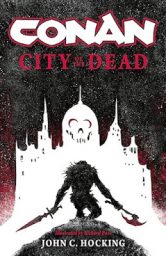 Conan (Rough Edges): For years, though, I’ve been meaning to read John C. Hocking’s novel CONAN AND THE EMERALD LOTUS, which has a pretty favorable reputation even among Howard’s most devoted fans. I believe it was Morgan Holmes who first told me that Hocking’s book is the best of the Conan pastiches published by Tor. I should have gotten around to it long before now, especially since the author comments from time to time on this very blog.
Conan (Rough Edges): For years, though, I’ve been meaning to read John C. Hocking’s novel CONAN AND THE EMERALD LOTUS, which has a pretty favorable reputation even among Howard’s most devoted fans. I believe it was Morgan Holmes who first told me that Hocking’s book is the best of the Conan pastiches published by Tor. I should have gotten around to it long before now, especially since the author comments from time to time on this very blog.
Fantasy (Sprague de Camp Fan): My de Camp highlight under review this time around is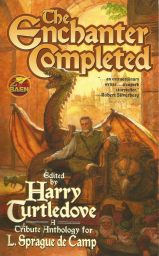 The Enchanter Completed: A Tribute Anthology for L. Sprague de Camp. Now that’s a mouthful! This is another one not actually by de Camp, but don’t let that stop you. Personally, I love this book, and if I didn’t love this book, I would still love the idea of it, as spelled out in the subtitle. Not all authors get these tributes, but Baen Books kind of specializes in them.
The Enchanter Completed: A Tribute Anthology for L. Sprague de Camp. Now that’s a mouthful! This is another one not actually by de Camp, but don’t let that stop you. Personally, I love this book, and if I didn’t love this book, I would still love the idea of it, as spelled out in the subtitle. Not all authors get these tributes, but Baen Books kind of specializes in them.
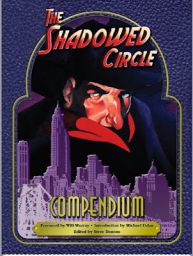 Pulp (Comics Radio): Fanzines and fan magazines have been largely replaced by blogs and wikis and that’s not a completely bad thing–especially for those of you who seek out the most brilliantly written blogs, such as… well, modesty prevents me. But fanzines and fan magazines had their own charm and they are missed. That’s why The Shadowed Circle is such a wonderful thing.
Pulp (Comics Radio): Fanzines and fan magazines have been largely replaced by blogs and wikis and that’s not a completely bad thing–especially for those of you who seek out the most brilliantly written blogs, such as… well, modesty prevents me. But fanzines and fan magazines had their own charm and they are missed. That’s why The Shadowed Circle is such a wonderful thing.
Actors (Wert Zone): News has sadly broken of the passing of Canadian actor Donald Sutherland, at the age of 88. One of the best-known actors of his generation, Sutherland had an enormous list of credits spanning almost sixty-five years.
Pulp (Dark Worlds Quarterly): Invisibility has become a familiar idea to the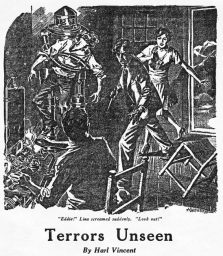 Pulps by 1931. It appears with some explanation (usually involving atoms) but is largely a given. Some writers like Philip Wylie and Paul Ernst build from H. G. Wells’s The Invisible Man (1897) while others glibly make their spaceships invisible before going on raiding runs. There is some innovation here though in small ways. Wells has done the heavy lifting and writers use the invisible trope to suit their narratives.
Pulps by 1931. It appears with some explanation (usually involving atoms) but is largely a given. Some writers like Philip Wylie and Paul Ernst build from H. G. Wells’s The Invisible Man (1897) while others glibly make their spaceships invisible before going on raiding runs. There is some innovation here though in small ways. Wells has done the heavy lifting and writers use the invisible trope to suit their narratives.
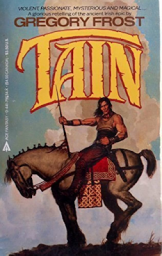 Fantasy (Silver Key): The ancient Irish were badasses (as are some of the moderns, I know of one Murphy who will soon bloody your lip as buy you a Guinness). As Britain’s kingdoms fell one by one to Viking raiders until Alfred stood alone, the Norsemen were never able to break the men of Ulster. See April 23, 1014 and Clontarf.
Fantasy (Silver Key): The ancient Irish were badasses (as are some of the moderns, I know of one Murphy who will soon bloody your lip as buy you a Guinness). As Britain’s kingdoms fell one by one to Viking raiders until Alfred stood alone, the Norsemen were never able to break the men of Ulster. See April 23, 1014 and Clontarf.
Comic Books (Atocom): Eastern Color’s 1954 one-shot Amazing Willie Mays heralded a baseball player with, at that point, only two years in the majors! Mind you, he had won Rookie of the Year in 1951.
Fiction (With Both Hands): Jim Breyfogle’s A Bad Case of Dead is in some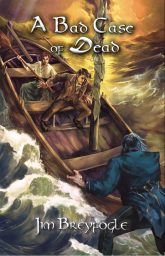 ways a very traditional romance in a Victorian setting. We find a grim and dirty, but quite lively London with many economic opportunities available to the bold and the lucky. Queen Victoria’s overseas dominions give Englishmen a sense of living in a much larger and more interesting world than the one they are accustomed to.
ways a very traditional romance in a Victorian setting. We find a grim and dirty, but quite lively London with many economic opportunities available to the bold and the lucky. Queen Victoria’s overseas dominions give Englishmen a sense of living in a much larger and more interesting world than the one they are accustomed to.
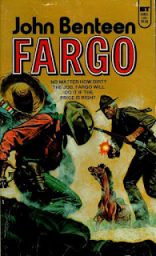 Fiction (Sorcerers Skull): I decided to check out the men’s adventure paperback series Fargo by John Benteen after discovering the whole series was cheap on Kindle. I’ve read blogpost reviews that refer to Fargo as sort of a “Western Conan.” I can see what they mean in that Fargo is tough as hell, irresistible to women (apparently due to sheer manliness.
Fiction (Sorcerers Skull): I decided to check out the men’s adventure paperback series Fargo by John Benteen after discovering the whole series was cheap on Kindle. I’ve read blogpost reviews that refer to Fargo as sort of a “Western Conan.” I can see what they mean in that Fargo is tough as hell, irresistible to women (apparently due to sheer manliness.
Writing (A Shiver in the Archives): It must have been in the late 1970s that I read Lloyd Alexander’s Prydain Chronicles (five novels, plus occasional shorter pieces collected in The Foundling and Other Tales of Prydain in 1982). I liked them, but wished they were a little less juvenile. Soon afterwards I also read his early novel, Time Cat. (This was before I declared the subgenre of cat fantasies verboten.) And I think I read a few others, but didn’t persist as I preferred fantasies written for adults rather than for children.
Actors (Fifties Westerns): Audie Murphy — the most-decorated American soldier of World War II and later a major star of 50s Westerns, was born on this day in 1925.
Warhammer (Lord Samper Library): Aaron Dembski-Bowden builds upon what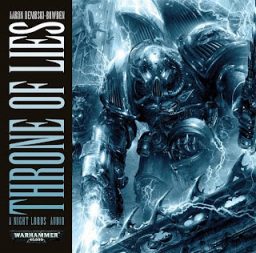 he began in ‘Soulhunter’ and expands his vision of a traitorous Space Marine chapter on the brink of extinction but still aiming to spit in the eye of the Imperium one more time before the inevitable occurs. As was the case with ‘Soulhunter’, I like the way that the Night Lords (while allied with their chaotic brothers) are rebelling for reasons of their own; it gives the whole scenario a little more depth and colour.
he began in ‘Soulhunter’ and expands his vision of a traitorous Space Marine chapter on the brink of extinction but still aiming to spit in the eye of the Imperium one more time before the inevitable occurs. As was the case with ‘Soulhunter’, I like the way that the Night Lords (while allied with their chaotic brothers) are rebelling for reasons of their own; it gives the whole scenario a little more depth and colour.
Awards (Locus): The REH Foundation has announced the winners of the 2024 Robert E. Howard Awards, honoring work that is “substantively devoted to the life and/or work of Robert E. Howard” or that “carries on the spirit and tradition of Robert E. Howard, to better recognize and celebrate his influence on future generations of writers.”
Art (Cats Paw Dynamics): In 1963, Robert K. Abbett was commissioned by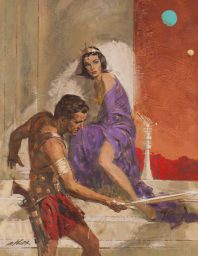 Ballantine Books to paint the covers for Edgar Rice Burroughs’ Barsoom series. 1965 saw the addition of John Carter of Mars as the 11th book, and Thuvia received a new cover in 1969. Abbett would also paint a Tarzan series of covers.society caught up. I’m sure someone more knowledgable than myself will bring some clarity to this.
Ballantine Books to paint the covers for Edgar Rice Burroughs’ Barsoom series. 1965 saw the addition of John Carter of Mars as the 11th book, and Thuvia received a new cover in 1969. Abbett would also paint a Tarzan series of covers.society caught up. I’m sure someone more knowledgable than myself will bring some clarity to this.
 Fantasy (DMR Books): The late heroic fantasy author David Gemmell needs no introduction for most of the readers of this blog. Morgan Holmes called him “The Man who Saved Sword and Sorcery Fiction,” and Steve Tompkins once referred to him as “our favourite genre’s second wind.” To most of his fans he was, and to many still remains, The King of Heroic Fantasy.
Fantasy (DMR Books): The late heroic fantasy author David Gemmell needs no introduction for most of the readers of this blog. Morgan Holmes called him “The Man who Saved Sword and Sorcery Fiction,” and Steve Tompkins once referred to him as “our favourite genre’s second wind.” To most of his fans he was, and to many still remains, The King of Heroic Fantasy.
Writing (Swords Lore): When it comes to preexisting stories with a fictional setting that is aware of itself being in space, there isn’t a lot to go off of when it comes to “purely Celtic” examples. Most are either mixed in with other elements—which is common in other speculative fiction genres using Celtic source material—or left out completely.
History (Frontier Partisans): On June 16, 1774 — 250 years ago — James Harrod and a group of 30+ frontiersmen laid out Harrodstown in the verdant grasslands of Kain-tu-kee. They had canoed down the Monongahela River and the Ohio in the midst of rising tensions with the Shawnee that would lead to Lord Dunmore’s War. They penetrated into the interior of Kain-tu-kee and camped at a likely spot that had all the desirable elements of a townsite.
Fantasy (Wormwoodiana): When The King of Elfland’s Daughter was first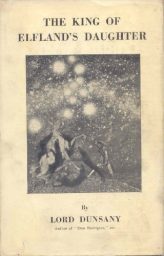 published one hundred years ago, it was Dunsany’s second novel (of fourteen, eventually, including one published nearly fifty years after his death), following The Chronicles of Rodriguez (1922; titled Don Rodriguez in the US edition), which is an oddly structured book, for Dunsany, in writing his first novel, seemed to think that all he needed to do was write a bunch of chronicles about the same character until he had enough pages to call it a novel.
published one hundred years ago, it was Dunsany’s second novel (of fourteen, eventually, including one published nearly fifty years after his death), following The Chronicles of Rodriguez (1922; titled Don Rodriguez in the US edition), which is an oddly structured book, for Dunsany, in writing his first novel, seemed to think that all he needed to do was write a bunch of chronicles about the same character until he had enough pages to call it a novel.
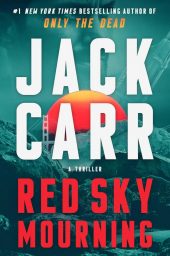 Thrillers (Real Book Spy): Jack Carr stuns with his latest thriller, Red Sky Mourning, the seventh in his #1 New York Times bestselling James Reece series, offering up a savage, brutal, and adrenaline-fueled thriller that reminds readers why he’s catapulted to the top of the genre while quickly becoming one of the very biggest names in publishing today.
Thrillers (Real Book Spy): Jack Carr stuns with his latest thriller, Red Sky Mourning, the seventh in his #1 New York Times bestselling James Reece series, offering up a savage, brutal, and adrenaline-fueled thriller that reminds readers why he’s catapulted to the top of the genre while quickly becoming one of the very biggest names in publishing today.
Fiction (Swashbuckling Planets): I started reading C. J.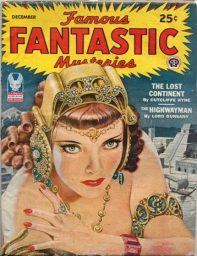 Cutcliffe-Hynes’ The Lost Continent yesterday, and I’m hooked. (It’s a free e-book at Feedbooks, link leads there). So far I’m at the fourth chapter, and our hero Deucalion, whose account was discovered by a slumming adventurer playing at archaeologist, has just been ejected from the Viceroyalty of Yucatan and summoned to Atlantis by the new Empress Phorenike for mysterious reasons.
Cutcliffe-Hynes’ The Lost Continent yesterday, and I’m hooked. (It’s a free e-book at Feedbooks, link leads there). So far I’m at the fourth chapter, and our hero Deucalion, whose account was discovered by a slumming adventurer playing at archaeologist, has just been ejected from the Viceroyalty of Yucatan and summoned to Atlantis by the new Empress Phorenike for mysterious reasons.
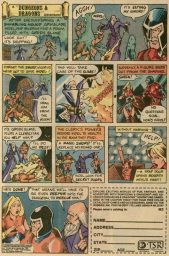 D&D (Dark Worlds Quarterly): It’s not hard for some us to remember Dungeons & Dragons (we never used the “Advanced” much. We just called it “Dee-N-Dee”) back in the late 1970s and early 1980s. The ads were in all the comic books and magazines, if you were addicted to those as well. It was a magical time to be into Fantasy, after the dribblings we got in earlier years.
D&D (Dark Worlds Quarterly): It’s not hard for some us to remember Dungeons & Dragons (we never used the “Advanced” much. We just called it “Dee-N-Dee”) back in the late 1970s and early 1980s. The ads were in all the comic books and magazines, if you were addicted to those as well. It was a magical time to be into Fantasy, after the dribblings we got in earlier years.
Lovecraft (Pulp Super Fan): In Lovecraftian People and Places, we get 12 essays collected into four sections: Lovecraftian People, Lovecraftian places, the fiction, and amateur journalism. While these articles may be too esoteric to be of interest to the casual Lovecraft fan, for those wanting to know more about the man and his works, you should check this collection out.
Robert E. Howard (FWTX.com): Robert E. Howard, who based a prolific pulp-fiction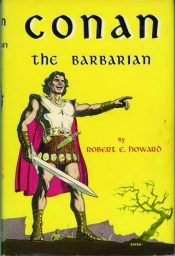 career of the 1920s and ’30s at a backwater west of Fort Worth, is known today as the creator of Conan the Barbarian, a mythical warrior whose exploits symbolize Howard’s distaste for the industrialization of rural Texas. His novelistic Conan series and its modern-day transmedia spinoffs are the most prominent outcropping of a wealth of rambunctious storytelling.
career of the 1920s and ’30s at a backwater west of Fort Worth, is known today as the creator of Conan the Barbarian, a mythical warrior whose exploits symbolize Howard’s distaste for the industrialization of rural Texas. His novelistic Conan series and its modern-day transmedia spinoffs are the most prominent outcropping of a wealth of rambunctious storytelling.
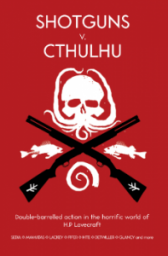 Mythos (Marzaat): There are no Weird Westerns here. Yes, there are spies and cops and robbers here. But what this book mainly has are shotgun-toting heroes and heroines not going gently into that stygian night, but raging against Cthulhu’s coming light. Editor Laws assures us that shotguns were not a de rigeur requirement for these stories, but they show up in most of them.
Mythos (Marzaat): There are no Weird Westerns here. Yes, there are spies and cops and robbers here. But what this book mainly has are shotgun-toting heroes and heroines not going gently into that stygian night, but raging against Cthulhu’s coming light. Editor Laws assures us that shotguns were not a de rigeur requirement for these stories, but they show up in most of them.
Pulp (Rough Edges): FAMOUS FANTASTIC MYSTERIES was a reprint pulp, but it reprinted some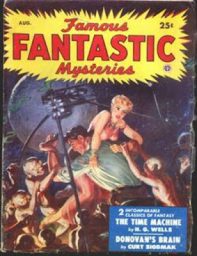 great science fiction and fantasy, sometimes obscure, sometimes well-known classics. And it had new, often great covers by some fine artists. This issue contains only two stories, both of them in the classic category: THE TIME MACHINE by H.G. Wells and DONOVAN’S BRAIN by Curt Siodmak.
great science fiction and fantasy, sometimes obscure, sometimes well-known classics. And it had new, often great covers by some fine artists. This issue contains only two stories, both of them in the classic category: THE TIME MACHINE by H.G. Wells and DONOVAN’S BRAIN by Curt Siodmak.
History (University of Aberdeen): Archaeologists have uncovered a Pictish symbol stone close to the location of one of the most significant carved stone monuments ever uncovered in Scotland.
Old Radio (Comics Radio): It’s not a good idea to break a promise to a ghost. In fact, it might not be possible to break a promise to a ghost.
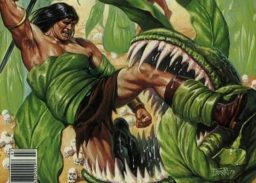 Fantasy (Dark Worlds Quarterly): Heroic Fantasy offers sword-swingers all kinds of monsters to fight: dragons, harpies, ape creatures, just about anything you can imagine. The Sword & Sorcery hero (along with the Epic Fantasy hero) sometimes face off against killer plants. The history of the plant monster in Horror fiction dates back to 1869. Writers like Robert E. Howard were familiar with either the Victorian version or the Pulp version of these deadly green killers. It is only natural they should take seed in tales of the fantastic.
Fantasy (Dark Worlds Quarterly): Heroic Fantasy offers sword-swingers all kinds of monsters to fight: dragons, harpies, ape creatures, just about anything you can imagine. The Sword & Sorcery hero (along with the Epic Fantasy hero) sometimes face off against killer plants. The history of the plant monster in Horror fiction dates back to 1869. Writers like Robert E. Howard were familiar with either the Victorian version or the Pulp version of these deadly green killers. It is only natural they should take seed in tales of the fantastic.
Robert E. Howard (Paperback Warrior): The August, 1936 issue of Argosy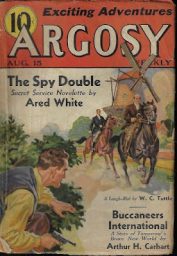 featured a horror western short-story titled “The Dead Remember”. The author was Robert E. Howard, a veteran of both westerns and horror stories. Howard was closely linked with Weird Tales along side his contemporaries in H.P. Lovecraft and Clark Ashton Smith. He made $17.50 for the submission.
featured a horror western short-story titled “The Dead Remember”. The author was Robert E. Howard, a veteran of both westerns and horror stories. Howard was closely linked with Weird Tales along side his contemporaries in H.P. Lovecraft and Clark Ashton Smith. He made $17.50 for the submission.
Please give us your valuable comment